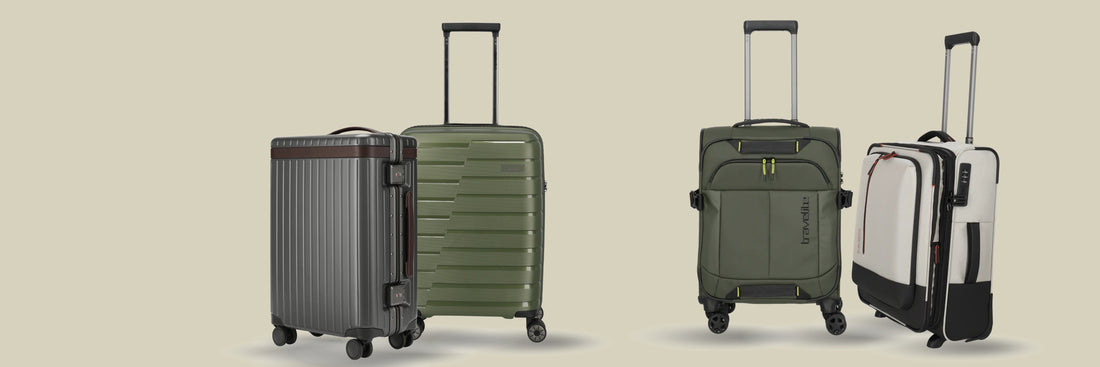
When choosing a cabin bag, one of the most common decisions travellers face is whether to go with soft shell or hard shell luggage. While both have their merits, the right choice depends on how you travel, what you pack, and which airlines you fly with. This guide explores the key differences between soft and hard cabin luggage—helping you decide which is the best fit for your next trip.
1. Flexibility and Expandability
Soft shell luggage is typically made from materials like nylon or polyester, which makes it far more flexible than its hard shell counterpart. This flexibility means soft bags can often be squeezed into tight spaces, like under-seat areas or overhead bins on busy flights. Many also come with expandable zippers, giving you a few extra litres of space when you need it most.
Hard shell luggage, on the other hand, is rigid. If your bag is even slightly larger than the airline’s cabin size allowance, there’s no way to compress it—and this could result in a gate check or extra fee.
Verdict:
If you regularly fly with strict airlines like Ryanair or easyJet and want to stay within a tight size limit, soft shell luggage is often more forgiving.
2. Protection and Durability
One of the main selling points of hard shell luggage is its ability to protect your belongings. These bags are usually made from materials like polycarbonate or ABS plastic, which provide a tough outer shell that can resist impacts and rough handling. This makes them ideal if you’re carrying delicate items like electronics, glass bottles, or breakable souvenirs.
Soft shell bags, while durable, don’t offer the same level of impact protection. However, high-quality soft luggage made from ballistic nylon can be surprisingly resilient and long-lasting, especially if you’re not checking the bag.
Verdict:
Choose hard shell if protection is a top priority, especially for valuables or breakables.
3. Accessibility and Organisation
Soft cabin bags often feature multiple exterior pockets, making it easy to access travel documents, snacks, or a laptop without opening the main compartment. This is especially useful when going through airport security or during a flight.
Most hard shell luggage, in contrast, lacks external pockets. You’ll typically have to unzip the entire case to access anything, which can be inconvenient—particularly in tight spaces like an aircraft cabin.
Verdict:
Soft shell luggage wins for easy access and better organisation on the go.
4. Weather Resistance
Hard shell luggage offers better protection from rain or snow, thanks to its water-resistant exterior. While not fully waterproof, it provides a strong barrier against splashes and damp conditions.
Soft shell bags are usually treated to resist water but can absorb moisture over time, especially through seams and zippers. If you're often outdoors, travelling through variable climates, or concerned about sudden showers, this is worth considering.
Verdict:
Hard shell bags are better suited for wet-weather travel.
5. Aesthetics and Style
Hard shell suitcases often look more sleek and modern, with smooth finishes and minimalist designs. They come in a wide variety of colours and are generally easier to clean.
Soft shell luggage tends to look more functional, and while it may not turn heads in the same way, brands like Carl Friedrik and Travelite offer refined soft-sided options that don’t compromise on style.
Verdict:
If you’re looking for a sleek aesthetic, hard shell has the edge—but soft shell is catching up in the style stakes.
6. Weight and Packing Capacity
Soft shell bags are usually lighter, which can make a big difference when trying to stay under a 10kg cabin bag allowance. They also tend to offer slightly more usable internal space because the material itself takes up less room.
Hard shell cases may be more structured but often weigh more—especially in budget or older models—leaving you with less weight allowance for your belongings.
Verdict:
Soft shell wins for lightweight travel and maximising packing space.
So, Which Should You Choose?
The answer depends on your travel style:
-
Choose soft shell cabin luggage if you:
-
Travel frequently with low-cost airlines and strict size rules
-
Need easy-access external pockets
-
Prioritise flexibility and lighter weight
-
Want a bag that fits under the seat or compresses easily
-
-
Choose hard shell cabin luggage if you:
-
Want better protection for electronics or fragile items
-
Travel in all weather conditions
-
Prefer a sleek, structured design
-
Don’t need to access items during the flight
-
Our Expert Tip
For most travellers, having one of each is the ideal solution. Use a soft shell under-seat bag for day-to-day essentials and quick access, and a hard shell cabin case for longer trips or when carrying valuables.
At The Cabin Luggage Company, we offer a wide range of both styles—from ultra-light soft bags to ultra-protective hard shells—all selected to meet airline restrictions. And with our Airline Size Restriction Guarantee, you can shop with confidence knowing your bag will be accepted at the gate.



